Business meetings in Japanese
Humor in Japanese
Practical Ideas & Resources
Resources in this section curated by: Risa Miura, Kaleb Stubbs

Sarcasm in Japanese: How it Works | Blog Post
This blog post explains Japanese sarcasm in general, then compares it to English and provides examples of Japanese sarcasm with explanations. There are also links to other resources that further explain some key terms.
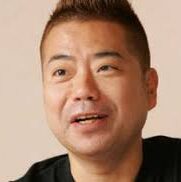
Degawa English | TV Segment
There is a popular TV series in Japan called Sekai no Hatemade Itte Q! One of the goals of the series is to explore places around the world and complete missions using English. The Japanese comedian Tetsurou Degawa has limited knowledge of English but tries to complete missions and find clues by communicating with locals. In a scene from London, he was trying to say the Japanese word zamaa miro, which means look at yourself. The subtitle of this phrase was written all in katakana characters even though zamaa is not a foreign word. The effect of subtitles was more sarcastic because of the way that Degawa uses the phrase mixing English and Japanese.

Post from @dewaymgt | Tweet

This is a great example for describing sarcasm by using deviate usage of the Japanese characters. At the bottom, it says ...oatoga yoroshii youde in katakana. The phrase sounds sarcastic as it means that's all from me. Because the phrase is derived from Japanese, writing it in katakana looks more sarcastic as it can imply distance, especially with the usage of ellipses at the beginning of the sentence.

5 Comedies that Best Explain the Japanese Sense of Humor | Article
Despite oft-repeated claims that Japan has one of the most homogenous societies on the planet, Japanese people and their culture are as diverse as any other nation on the planet. This extends to their sense of humor, which is multifaceted and varied; the best way to understand it is by watching Japanese comedies. This article suggests five comedies as a good starting point.

Unspoken Rules: How to Read the Air in Japanese Companies | Article
Reading the air is important in Japan, which contributes to a form of humor when someone is unaware of or cannot understand the unspoken rules of a group. It is especially popular with young people as slang to mock their friends or complain about annoying encounters. However, the concept of people being KY is one that often troubles Japanese companies—especially when hiring foreigners.
The “air” is invisible, therefore it cannot be described, yet is expected to be understood in order to maintain harmony. One who is not correctly reading the air can be easily spotted and may be the subject of a joke or scorn. Other terms, such as aun no kokyu, meaning being perfectly in unison, or anmokuchi, meaning tacit knowledge, are valued positively and recognized for requiring high levels of emotional intelligence. Unsurprisingly, those who are unable to catch an unspoken message can easily become an object of scorn.

#Nazokake | Twitter Hashtag

A) Mezamashi dokei to kemashite
B) Hajimeteno senkyo to toku
(sono kokoroha)
Dochiramo otonatte kidukuimasu.
In this nazokake, the word otonatte has a double meaning: A) mezamashi dokei means an alarm clock and B) hajimeteno senkyo is the first election in one’s life in which one is able to vote. Both A) and B) make you realize by relating the word otonatte. Here, otonatte for A) means sounds from the alarm clock go off to make you wake up. Otonatte for B) means to make you realize that you are an adult (by law). However, Japanese use different Chinese characters to differentiate the two meanings and also change the tones.

100 Nazokake Questions | Article
好きな人と掛けまして 嫌いな人と解きます (その心は) どちらもはなしたくないでしょう。(話す/離す)
A) Sukinahito tokakemashite
B) Kirainahito totokimasu
(sonokokoroha)
Dochiramo hanshitakunaidesyou
In this nazokake, the word hanasu, which is a dictionary form of hanashi in hanashitakunaidesyou, has a double meaning. A) sukinahito means a person who you like/love and B) kirainahito means a person who you do not like. The punchline hanasu in this example has two ways to differentiate the meanings by using different Chinese characters. Hanasu in A) means to keep distance with; however, in the context of B), hanasu means to talk with.

Dad Jokes | Article
・内容が無いよう (naiyou ga naiyou)
There are no contents
・アルミ缶の上にあるみかん (arumikanno ueniaru mikan)
A mandarin orange on an aluminum can
・「アイスを食べよう」「あ、いっすね」(aisu wo tabeyou)(a, issune)
"Let eat ice cream" "Yeah, that sounds good"
・バスガイドに乗る前にバスが移動 (basgaido ga norumaeni basu ga idou)
A bus was moving before a bus guide got on
Although the translations don't deliver the same punch line as they do in Japanese, the sounds of the words that are used in the Japanese version sound almost identical and carry different meanings. This is a play on not only the sounds of the words, but the words themselves.
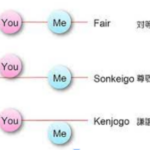
Table of Honorific Categories in Japanese | Image

This image shows the three of the levels of honorifics that are used in the Japanese language. The use of Keigo is the basis of understanding how sarcasm works. When talking to someone of equal status as you, 対等 "taitou" is used. When the listener is of superior status, 尊敬語 "sonkeigo" is used to honor that listener. In the same context, 謙譲語 "kenjougo" is used to humble yourself in front of that superior. By using 尊敬語 "sonkeigo" or 謙譲語 "kenjougo" in a situation that the two speakers are of equal status, this could imply that sarcasm is being used. Although this could represent genuine respect as well, depending on the context and gestures given, one could alter the illocutionary force of the utterance to imply sarcasm.
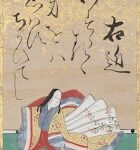
Ukon's Waka | Blog Post

The poet of this waka, Ukon, and her husband are breaking up after their marriage because the man was cheating on her. Instead of whining around all day, Ukon decides to express her emotion through waka using sarcasm.
「忘らるる 身をば思わず 誓いてし 人の命も惜しくもあるかな」-右近 (百人一首 第38番)
English translation:
Though he forsook me,
For myself I do not care:
He made a promise,
And his life, who is forsworn,
Oh how cruel it would be!
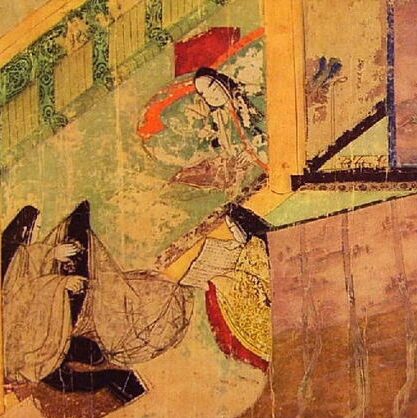
Emakimono | Manga


These are photos of the first ever manga written in Japanese history. Emakimono means painted handscrolls, which were the platforms for how manga first started. The interactions between frogs, a hare, and a monkey were intended to portray human characteristics in the form of animals. The first picture, named Chōjū-jinbutsu-giga (鳥獣人物戯画, literally "Animal-person Caricatures"), is considered to be the most famous and is one part of a set of four scrolls. These belonged to Kōzan-ji temple in Kyoto, Japan. It is believed to have been created by multiple artists. This was the beginning of an era of lively animations that were soon to follow and evolve into what we see now in today's manga and anime.

Neducchi's Nazokake | YouTube Video
Nazokake is a type of game of telling a riddle using words with the same or similar pronunciation but different meanings. There is a formula to tell nazokake in Japanese: (I came up with an idea) A x B (sono kokoro ha)= punch line. In Japanese, one says totonoimashita, A to kakete B to toku (Everyone else says) sono kokoroha, dochiramo (punch line). In the video, the Japanese comedian Neducchi, who is well known for his fascinating ability of telling a riddle, says:
Totonoimashita
(I came up with an idea).
(A) Dramu to kakete (B)waruikotowo suru to toku
(Drums and doing bad things)
(Everyone: sono kokoroha)
(Why is A like B?)
Dochiramo bachiga atarune
(Both bachiga atarune)
Therefore, bachiga ataru has double meanings: one is drums, drumsticks hit the drums, and the other is for waruikotowo suru, bachiga ataru meaning to incur divine punishment.
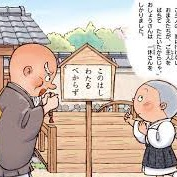
The board says "Konohashi wataru bekarazu" | Japanese Wit

Probably the most famous wit or tonchi in Japan would be "konohashi wataru bekarazu" from Ikkyusan. The two people in the comic get confused when they are invited by a man living across the bridge because the sign states, "do not cross hashi". Many assume hashi in this context means bridge. The little boy named Ikkyusan uses his wit to get to the man's place. Here, he and his master cross the bridge by understanding hashi as the edges, so they walk in the middle of the bridge. In Japanese texts, people differentiate those two homonym by using different Chinese characters and tones (橋/端).

President Pompoko | Manga

In this manga, kaji is a keyword for understanding why the man misunderstood Hanako when she said the second line. Kaji is intentionally written in hiragana to let the reader guess which kaji Hanako is mentioning. In this conversation, kaji means either house chore or fire, so the man assumed that Hanako helps do house chores in her house. However, after she heard the siren, she changed her clothes to prepare for extinguishing the fire around her neighbor. Now, the man understands that Hanako does not help do her house chores, but rather assists the fire department team in her town.
Man: Hanako, what do you do?
Hanako: Yes, I help kaji......
Man: Hmm, how plebeian you are (despite the fact that her house and her clothes look fancy)
-Heard the siren -
-Hanako went to help the fire department-
Man: You are a member of the fire department in town…
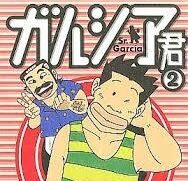
Garcia-kun | Manga

Garcia learned the implication of asameshi-mae, whose literal meaning is before breakfast, but whose idiomatic meaning is the same as a piece of cake. Although it seems he understood the implication from the context with woman 1, he misused and said asagohan-mae, which also means before breakfast. Here, meshi and gohan both mean meal(s), the former sounds more masculine but not formal. The latter is a neutral term; it is used by both genders. However, as an idiomatic phrase, it must always be asameshi-mae and not asagohan-mae. As a consequence, Garcia is offered breakfast by a random woman.
Garcia: You're good at flower arranging
Woman 1: It's easy. It's just a piece of cake
Garcia: ......okay
Woman 2: Oh, you are so strong
Garcia: Y, yes. It's before breakfast
Woman 2: Please have some meal
Garcia: ?

Summit School | Manga

In this comic, takusan, which means “many", is written in hiragana instead of normal hiragana or Chinese characters. At least the last two words that the students listed are one of the societal issues in Japan. Karo-shi means “die from work", and ijime means “bullying”. Here, takusan in katakana implies sarcasm because many words they know in Japanese provoke controversial problems in Japan, which makes Jiro scared to spend time with the students. Some of the classmates' hairstyles might also give Jiro an impression of them as scary people.
Woman: This is Jiro and he moved here from Japan
Students: We know many Japanese words
Sony, Honda, Sagawa, Kanemaru, Kenkin, karo-shi, and ijime
Jiro: Nice to meet you (with his voice shaking)
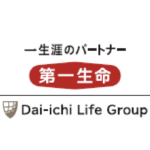
Sarari-man senryu from Daiichi Life Company | News Article
Every year, Daiichi-life company holds a large competition of original senryu. In this news article, there are examples of the top one hundred rewarded senryuu of 2021.
・ふところが 寒いもともと キャッシュレス - 船橋ブン
(Futokoroga samui motomoto kyassyuresu -Created by Bun Funabashi)
A Japanese idiomatic expression, futokoro ga samaui, means being short of money. Motomoto means originally and kassyuresu means cashless or non-cash payment. Non-cash payment recently began to be highly valued especially due to COVID, however, Japanese society has traditionally accepted cash only. Therefore, this senryuu has a sense of irony as it can be translated as “I am already living a humble life before the trend of cashless payment hit".
・バスケ・父 勝敗分けた リバウンド -(祝女子バスケ銀)
(Basuke・chichi syouhai waketa ribaundo -Created by Syuku jyoshi basuke gin)
In this senryuu, the Japanese word ribaundo implies two meanings: a ball rebounding in basketball and to regain weight. Therefore, this senryuu has a sense of irony. It can be translated as "my father was a basketball player, and rebaundo decided the winner".
・「シュウカツ」や 君はスタート 俺ゴール - (一枚岩)
("Syuukatu" ya kimiha syuta-to ore go-ru -Created by Ichimai iwa)
This senryuu employs a witty way of using homonyms. The author implies it by using the word syuukatu in katakana with a Japanese quotation mark, which can emphasize double meaning and/or sarcasm by giving readers some space to imagine its meaning and implication. In this senryuu, syuukatu has two meanings: job hunting and prepare for the end of one's life. Japanese differentiates the meaning by using different Chinese characters. Therefore, this senryuu can be translated as "you are on the start line of job hunting whereas I am heading towards the end of my life".
・巣ごもりで MからLに 服反応 - (ダイエット)
(Sugomoride M kara L ni fukuhannou -Created by Daietto)
This senryuu also utilizes the homonym of "fuku". Under COVID restrictions, the Japanese word sugomori became a bus word which literally means hibernation. The creator uses a different kanji for fuku in fukuhannou which means side-effects, so this senryuu can be translated as "Hibernation from society has changed my size of clothes from medium to large, and the clothes reflect the shift".
・テレワーク 解除で妻が 福反応 - (風信子)
(terewa-ku kaijode tumaga fukuhannou -Created by Nobuko Kaze)
This senryuu employs the same technique as the previous one, but it uses a different Chinese character for “side-effect”, even though it is pronounced the same as the original fukuhannou. In this case, the Chinese character for fuku means fortunate so this fukuhannou is not side-effect, but rather good-effect. Terewa-ku means telework, kaijo means to release or cancel restrictions, and tuma means wife. Therefore, this senryuu can be translated as "My wife looks happy after the cancelation of telework".
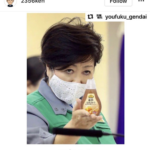
Oogiri from Syouten: #Zabutonichimai | Instagram Post

Oogiri is another type of Japanese humor where professional rakugo storytellers must give a witty reply to a question and get some laughs. During the performance, storytellers can get a zabuton cushion when they succeed to initiate big laughs. There is a long-running TV show called Shyouten in Japan, and whenever someone says somethings witty and makes people laugh, one may say "zabuton ichimai" which literally means "I will give you a zabuton cushion (as a token)", but it implies "that is a good one".
Even though rakugo or oogiri are not common things to enjoy among the younger generation, the phrase zabuton ichimai is still understood and used to add a sense of humor. The woman in the Instagram post is Yuriko Koike. She is the governor of Tokyo Metropolis, and is well known for spreading her message by coining a new word to draw people's attention, especially during the COVID pandemic. One of the new words she addressed to avoid meeting with people in a close distance is sanmitsu, which shares the same concept as 3Cs. Mippei (Closed-spaces), Missyuu (Crowed-spaces) and Missetsu (Close-contact settings). In Japanese, the first letter of all three key words are written in the same Chinese character, so she named this as 3 mitsu. This picture says "8 mitsu desu". The number 8 is pronounced hachi in Japanese, and hachimitsu means honey. That is why she is holding a bottle of honey in her hand.

“Rakugo” (The Art of Storytelling) | Article
Rakugo website is a type of Japanese comedy where the speaker tells a funny/interesting story while doing different voices for the characters in the story. It's a traditional form of stand up comedy, or in this case sitting. This is an important source to introduce a type of humor that is much different from western countries. There has also been a popular trend of foreigners doing this type of Japanese comedy.
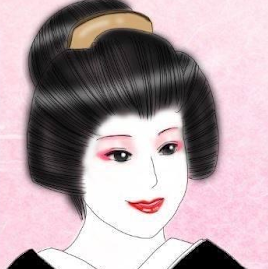
Keigo (Honorifics) Example | Facebook Post


A woman from Kyoto uses keigo to say "kireina omeshimono yanee", which means "your cloth is pretty". In normal speech, you can say fuku to describe clothes instead of omeshimono. In this high context situation, the woman implies that it is not good on you (at all). Therefore, the correct response for this is to humble yourself by saying something like "No, I was about to change my clothes for going out". Otherwise, this woman would think that you are unsophisticated.
This is also a sarcastic meme of people in Kyoto, Japan. A woman says in Kyoto dialect, "yoroshiosunaa", which literally means "that is good" or "that sounds good". However, through the lens of illocutionary force, this actually means that "I do not care" or "I am not interested in it (at all)". Yoroshii is a type of keigo and in normal speech, Japanese people use "ii", which both mean "good". Since the woman uses yoroshii instead of ii, it sounds sarcastic. The correct response for this high context situation would be to change the topic.

A Canadian Rakugo-ka's Witty Take on Traditional Japanese Storytelling | Interview
This is a full interview of the first foreigner to be trained by a Japanese Rakugo master (Katsura Bunshi) to be a performer of Japanese traditional comedic storytelling. This is a Canadian man that has taken the name of Katsura Sunshine as his stage, and has performed both in Japanese and English. He has had to learn the Osakan Japanese dialect, because Osaka is the home of Rakugo performances. At the same time he has had to learn which stories are easier to translate and bring the same cadence and techniques that his master has taught him. This is an important perspective for learners of Japanese language, because they need to see that they have humor, its just that the rules and traditions are different from western countries.

【英語落語】オチまでカウントダウン?桂三輝の「ショート落語」| YouTube Video
This is a video by Katsura Sunshine, doing a brief explanation of Rakugo in English before he begins his performance. This is a good resource for teaching people who are learning Japanese about the rules of Rakugo with a short story as an example.

Craziest Japanese Pranks Compilation! LOL | YouTube Video
These pranks shows are similar to prank shows in other countries, as some of them are people pranking strangers. The main difference is that in many of these shows, there is a small screen that shows the live reactions of the hosts that are also watching the clip with the audience. The implication being that the viewers want to feel closer to the popular show hosts and laugh with them about the extravagant pranks. Students can watch the video and analyze the reactions and comments from the hosts watching the funny videos.
